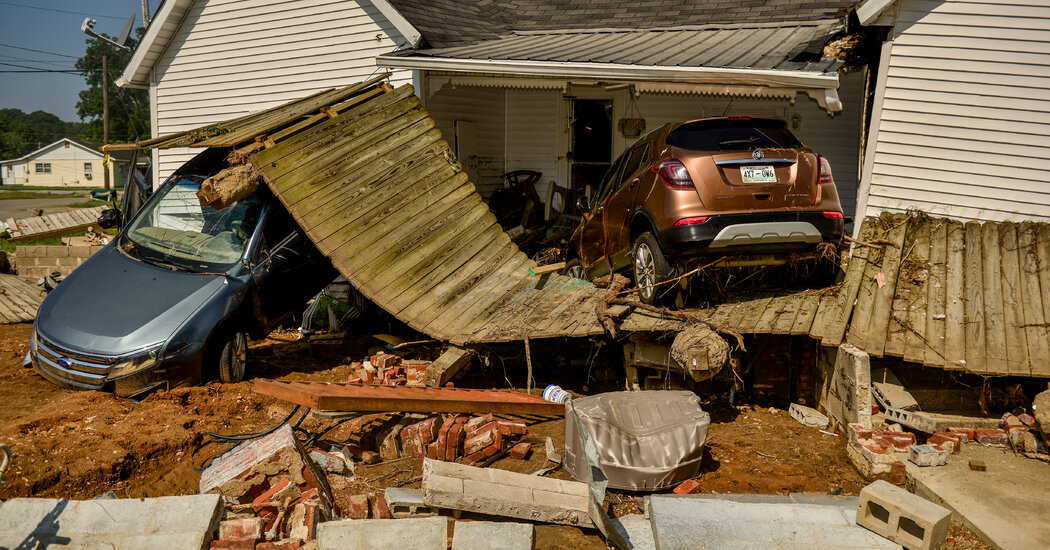
The floods that killed at least 20 people in Tennessee last weekend arrived with shocking speed and force — seemingly a case study of the difficulties of protecting people from explosive rainstorms as climate change gets worse.
A closer look at what happened in the days, years and even decades before the storm reveals that a series of government decisions — where and how to build, when to update flood maps, whether to join the federal flood insurance program and how to warn of dangerous floods — left residents more exposed to flooding than they had to be.
Record rainfall, at times exceeding 3 inches an hour, swelled rivers and creeks in Middle Tennessee on Saturday, destroying homes, cutting off power and cellphone service and washing away bridges. Among the dead are 7-month old twins, a 15-year-old girl and an Army veteran who died after helping his wife and daughter escape.
It’s impossible to say whether any single action could have prevented those deaths, especially given the ferocity of the flooding. But interviews with climate and disaster experts and a review of state and federal data show how governments have been slow to adapt to growing threats and failed to take steps that, together, could have lessened the damage.
“These extreme weather events will become more intense and more frequent,” said Hiba Baroud, a professor of civil and environmental engineering at Vanderbilt University in Nashville who specializes in resilience. “We need to be more proactive, and think about ways to prevent or at least mitigate the impact of these events.”
Refusing flood insurance
The story of the disaster in Humphreys County, the hardest-hit area in the state, arguably begins in the late 1970s, when the federal government began offering communities around the country a deal: If they agreed to take basic precautions to limit the damage from flooding, the government would let people in those communities buy publicly subsidized flood insurance.
Most cities and counties said yes. But not all of them. Humphreys County, which was the hardest hit by the floods of the past weekend, declined to take part, federal records show. So did neighboring Houston County, which was hit as well over the weekend. (Some cities within those counties, such as Waverly, which was hit hardest by the floods, do take part in the program.)
A spokeswoman for Humphreys County said officials there were unavailable to comment. But in general, communities that decide to stay out of the flood insurance program typically do so because of an aversion to building restrictions, according to Roy Wright, who ran the program until 2018.
Not participating in the flood insurance program hurts communities in a number of ways, according to Chad Berginnis, executive director of the Association of State Floodplain Managers. It means people can’t buy flood insurance, making it harder to rebuild after a flood. And it prevents people from getting some types of disaster assistance from the Federal Emergency Management Agency.
No building codes
As officials in Humphreys County spurned the federal government’s offer of flood insurance, they were shaping the future of the county in another way: By declining to adopt residential building codes.
Those codes govern the way houses must be built, to make them more likely to withstand natural disasters and other dangers. For example, Nashville, where catastrophic flooding in 2010 displaced thousands of people, requires the ground floor of new houses be constructed at least four feet above the expected height of a major flood, one of the toughest requirements in the country.
But Humphreys County, despite being only 70 miles west of Nashville and subject to a similar threat from flash floods, has no building code, according to state data. Nor does Houston County, along with some three dozen other counties in Tennessee. (As with flood insurance, some cities within those counties have their own codes.)
That difference is possible because of a decision by Tennessee lawmakers to avoid imposing rules on local governments. While most states adopt a building code and make that code mandatory for all of their cities and counties, Tennessee lets local governments decide whether to follow the state rules, or establish rules of their own, or have none at all.
“Any kind of standard or code is to protect the public,” said Norma Jean Mattei, a former president of the American Society of Civil Engineers and a professor at the University of New Orleans. “It really is all about public safety.”
In Houston County, Mayor James Bridges said he’d like to have a building code. But he said there wasn’t enough tax revenue to pay for the staff to manage and enforce those rules.
“With 8,000 people and a very small tax base, we just don’t have the money to have all these different departments that they have in larger cities,” Mr. Bridges said. “We have so many other needs.”
Extreme Weather
Flood maps understated the risk
As homes were being constructed in Humphreys County without a building code, the county’s ability to prepare for flooding was also being affected by a decision in Washington.
FEMA produces maps showing which areas are at risk from flooding, so that homeowners, builders and local officials can make informed decisions about where and how to build houses. Federal law requires the agency to review its flood maps at least once every five years and update them if needed.
But the map for Humphreys County hasn’t been updated since 2009, according to FEMA data. Hickman County, which is southeast of Humphreys and also flooded, hasn’t had its map updated since 2008.
In addition to being out of date, the methodology used by those FEMA maps underestimated the extent of the flood risk facing the region, according to calculations by the First Street Foundation, a group of academics and experts who issued their own estimates last year, which Realtor.com uses to inform home buyers about flood risks.
FEMA’s flood maps show that just 781 properties in Humphreys County are at risk from a so-called 100-year flood, 6.2 percent of all properties. First Street estimates the number is more than three times higher.
In other counties affected by the flooding last weekend, the discrepancy is even greater. The number of properties threatened by flooding in Hickman County, based on First Street’s data, is five times higher than what FEMA’s maps show. In Dickson County, the number is ten times higher.
That difference reflects the fact that FEMA’s maps look at the flood threat from main river channels but don’t address the risks from smaller creeks and tributaries, according to Jeremy Porter, a professor at the City University of New York and head of research and development for First Street. “All of the smaller tributaries and streams that were overwhelmed with precipitation runoff are currently unmapped in this area,” Dr. Porter said.
A spokeswoman for FEMA, Jaclyn Rothenberg, said the agency prioritized which areas to update first, and the onus was on local officials to seek new maps. Humphreys County and Hickman County “have not made requests for map updates,” she said. Ms. Rothenberg said the contrasting flood maps developed by FEMA and First Street were “different tools for different intended uses.”
Vague warnings
By the afternoon of Friday, Aug. 20, as weather forecasters in central Tennessee began to predict intensifying rain overnight in Humphreys County — an area with no building codes, no flood insurance and outdated flood maps — there was one big decision left: When and how to warn people.
At 4:55 p.m., the National Weather Service’s Nashville office asked local TV and radio stations to warn people that, in addition to the heavy rainfall of the previous few days, that night could bring an additional 2 to 4 inches.
“Higher amounts may be possible,” the message said. “Be prepared to take action should Flash Flood Warnings be issued.” It did not say what action people should be prepared to take.
At 6:09 a.m. the next morning, the Weather Service began sending warnings directly to cellphones. “A FLASH FLOOD WARNING is in effect for this area,” that message said. “Do not attempt to travel unless you are fleeing an area subject to flooding or under an evacuation order.”
But by the time those first messages started hitting people’s phones, there was little time to react. “They received the notification on their phone at about the same time the water was at their door,” said Dale Popp, the emergency management director for Houston County.
The warnings from the National Weather Service should have gone out before the flooding started, according to Sarah Tuneberg, an emergency manager who started a company called Geospiza that helps local governments protect people during disasters. And she said those warnings should have given people specific instructions on whether to leave their homes.
Krissy Hurley, the warning coordination meteorologist for the National Weather Service in Nashville, said her office decided to alert people to avoid travel once it got reports of roads flooding. She said the agency was wary of sending alerts too early.
“If you did that before it starts raining, people are going to get really annoyed at you,” Ms. Hurley said.
And her office doesn’t have the authority to customize the phrasing in those alerts, Ms. Hurley said, which she said were standard messages agreed to by the National Weather Service and FEMA.
In McEwan, a town in Humphreys County, Linda Ragsdale saw the warnings. But, as she recalled them, the alerts were vague and generic, cautioning that there could be flooding in Middle Tennessee.
She had no inkling that she would wind up crawling into her attic with her dog, her medication and her cellphone, waiting for hours while she could hear wood in her house groan and snap.
Her son called her early Saturday morning, asking if she’d gotten any water. “You could see puddles in people’s yards,” she said. “That’s all.”
Around 8:30 a.m., she got up and looked again. The surge was filling her yard. The water, she said, was “swift and quick, and I didn’t have time to get to my car.”
Several feet of water rushed through her home. It was gutted. She lost her car as well. She said she did not have flood insurance, nor did anyone else on her street.
“I don’t know what I could have done,” Ms. Ragsdale added. “It just happened so quick. It was too quick.”
Rick Rojas and Jamie McGee contributed reporting.


Average Rating